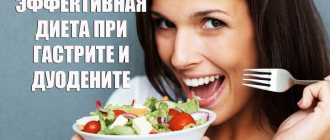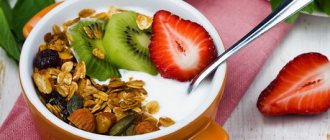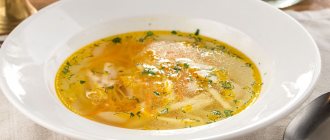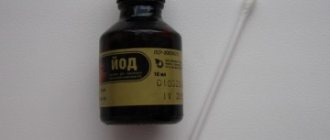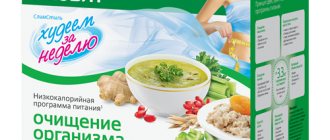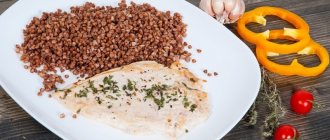Any person suffering from gastrointestinal diseases knows that it is not the treatment itself that is tiring and difficult to bear, but the diet. It is very difficult to get used to a new way of life, give up your usual food preferences, and constantly remember what you can’t eat with GERD and what you can.
However, it is impossible to cure GERD, especially with inflammation of the esophagus, reflux and other unpleasant symptoms, without following a diet. And, conversely, strictly following the recommendations of nutritionists will help a speedy recovery.
Guiding Principles of Nutrition
To prevent exacerbation and improve the patient’s current condition, doctors recommend strictly adhering to basic nutritional rules. These include the following recommendations. The dishes served to a person should be varied, and the nutrition should be balanced, that is, provide the body with all the necessary vitamins, minerals and microelements.
Small meals are recommended - at least 5-6 times a day. The patient should not overeat. To do this, you not only need to reduce portions, but also serve food on a smaller plate. Visually, the portion will look larger than it actually is. It is necessary to limit the consumption of salt and seasonings as much as possible.
It is advisable to completely remove spicy, fried, salty, and smoked foods from your diet. They have a bad effect on the inflamed mucous membrane of the esophagus, intensifying the current symptoms. Fresh onions, garlic, hot peppers and any spices are completely excluded from the menu. The last meal should take place at least 2-3 hours before going to bed.
Snacks on the run and dry meals are strictly prohibited. Food must be chewed thoroughly, well moistened with saliva. After eating, any physical activity or exercise is completely prohibited. You can do household chores after at least 1 hour. This will prevent the development of reflux (reflux). After eating, it is advisable to take a short walk.
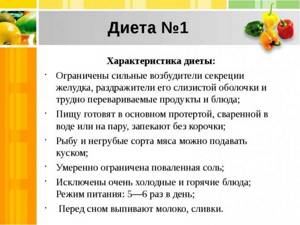
Important! With this pathology, patients are prohibited from taking fasting days. This can cause increased pain and the development of heartburn.
Additional recommendations
Following simple rules will help reduce the severity of symptoms of the disease:
- Before eating, drink 200 ml of cold boiled water to reduce the acidity of gastric juice;
- Avoid drinking alcohol;
- Food should be of moderate temperature: not too hot, but not too cold;
- A few pieces of raw potatoes, ¼ cup of potato juice or 2-3 walnuts will help reduce the likelihood of reflux;
- Avoid nighttime meals that only provoke heartburn;
- If the pain syndrome is severe, you can eat while standing, and after eating you need to sit or walk for 3 hours;
- Before going to bed, it is recommended to drink a decoction of chamomile herb, which has an anti-inflammatory and calming effect.
Reflux esophagitis is a chronic pathology, so diet and treatment only involve reducing the frequency of attacks of the disease. Violation of nutritional principles will lead to relapse and further exacerbation of the inflammatory process. Therefore, therapeutic nutrition should become an integral part of the patient’s life.
List of prohibited products
A diet for GERD with high acidity - low levels accompany this pathology in exceptional cases - prohibits many foods. But first of all, you need to give up the following:
- Drinks – alcohol-containing, strongly brewed black teas, cocoa, coffee, any soda, drinks with mint flavor and prepared on its basis.
- The dishes are spicy in taste.
- Chocolate.
- Vegetables and fruits that can cause heartburn. The list is individual in each case.
- Dairy products with high fat content - milk (more than 2%), yoghurts, cheeses, cottage cheese, cream.
- Roasted meat products.
- Fried foods, in particular potatoes.
- Fast food.
What foods should you avoid?
Any diet involves limiting the consumption of certain foods that lead to a worsening of the patient’s condition. Regardless of the stage of esophagitis, it is recommended to exclude:
- Sauerkraut, fresh and pickled cabbage, mushrooms, legumes, chocolate and products based on it, black bread, turnips, radishes, spicy dishes, sweet fresh pastries, ice cream, pastries and cakes, candies. These products cause increased gas formation, which leads to increased intra-abdominal pressure and the development of reflux.
- Fresh vegetables and fruits, garlic, sour juices, vinegar, rich broths, fatty meats (beef, duck, pork, lard) and fish (catfish, sturgeon), jellied meat. They lead to excess secretion of gastric juice. Therefore, it is recommended to exclude products during an exacerbation. Tomatoes are strictly prohibited.
- Sauces, seasonings, store-bought crackers and chips, spices, smoked meats, marinades. These foods increase stomach acidity and gas formation.
- Milk. It helps quickly relieve heartburn. But milk protein and the calcium it contains increase the secretion of hydrochloric acid. Therefore, the attack occurs again.
- The consumption of alcoholic beverages, coffee and strong tea is strictly prohibited.
List of approved products
The diet for gastroesophageal reflux disease is quite varied, which is due to a fairly wide list of permitted foods.

What to eat:
- Eggs. They are served exclusively soft-boiled (no more than 2 pieces per day) or in the form of an omelet cooked in a double boiler.
- Low-fat fish - navaga, perch, cod, carp, pike perch.
- Dietary varieties of meat are veal, poultry (the skin must be removed), beef, rabbit. Can be served in the form of meatballs, cutlets, soufflés and casseroles. Steam or bake in the oven under foil.
- Fermented milk and low-fat dairy products. After meals, low-fat yogurt, yogurt and kefir are allowed. Cottage cheese seasoned with sour cream or in a casserole. Non-acidic sour cream can be used for dressing. Milk - depending on individual intolerance.
- Vegetable oils (corn, olive, sunflower) - no more than 20 ml per day.
- Butter – no more than 20 grams per day.
- Fresh vegetables - peeled tomatoes, cucumbers, cabbage with soft leaves, carrots, greens.
- Potatoes, peas, pumpkin, zucchini - for making purees and casseroles.
- Yesterday's bread made from wheat flour.
- Porridge (semi-liquid or pureed). Semolina, oatmeal, rice and buckwheat are allowed.
- Sweets - marmalade, plain cookies, jelly, jelly, marshmallows.
- Fruits and berries with a sweet taste, in particular watermelon. They help strengthen the immune defense and also provide the body with all the necessary vitamins. But if you have GERD, eating them fresh is prohibited: they can provoke heartburn by increasing the production of gastric juice. Bananas and exotic fruits should be eaten before meals.
- Soups. To prepare the dish, skimmed (low-fat) broths are used. It is prohibited to use all types of legumes (peas, beans, lentils) for thickening. It is advisable to prepare puree soups, since they have virtually no effect on the mucous membrane of the esophagus and stomach. The menu can be varied with pasta, fruit, and milk soups. They can also be prepared from fish or chicken.
- Side dishes. Pasta can be served no more than 2 times a week. Mashed potatoes.
Diet according to Pevzner
When diagnosing GERD, the patient is assigned to table No. 1. It is necessary to observe it during the period of exacerbation or during the initial detection of the disease. Duration – 1 week. The menu includes gentle dishes that can have minimal impact on the inflamed esophageal mucosa. This promotes accelerated healing and scarring of the resulting ulcers.
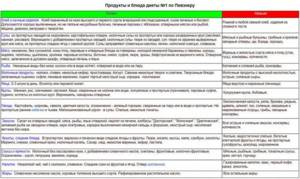
Allowed foods can be boiled or steamed. Dishes are served pureed or liquid. Serving hot or cold is prohibited: food must be warm. The patient is served steamed omelettes, jelly, soups, and various cereals. Meals for GERD are divided - every 3 hours in small portions. The diet for GERD with esophagitis and high acidity of gastric juice has some differences.
If the disease is complicated by the development of esophagitis, then the patient’s food is served exclusively pureed. This solves the typical problem of dysphagia for this form of the disease (pain when swallowing, food getting stuck in the throat). For breakfast, it is recommended to serve porridge and warm teas; kefir is ideal for an afternoon snack. For lunch - puree soup. Boiled vegetables can be garnished with mashed potatoes, first crushed using a blender.
With a combined course of GERD and gastritis, in which acidity is increased, a gentle diet is necessary. Sweets, spices, fatty/spicy foods, and carbonated drinks are strictly prohibited. The menu must be agreed with the attending physician.
Advice! For severe heartburn, the menu should include rice, baked apples, and jelly.
During the period of exacerbation of GERD, in addition to taking medications, it is necessary to follow a strict diet. The patient is allowed porridge cooked in water and other boiled dishes. You need to follow it for one to two weeks, until your overall well-being improves.
Sample daily menu:
Diet for reflux esophagitis + menu
- breakfast - porridge and rosehip decoction;
- second breakfast - cottage cheese;
- lunch - soup, boiled breast with a side dish of boiled vegetables;
- afternoon snack - vegetable salad of boiled beets with carrots, seasoned with vegetable oil;
- dinner - vegetable stew or cottage cheese casserole.
During the period of remission of the disease, the list of permitted products can be slightly expanded. For example, a patient can eat sweets, but in limited quantities. Fatty dishes and foods are still prohibited.
Sample menu for the day:
- breakfast – cottage cheese with sour cream, tea, dry biscuits;
- second breakfast - sweet berry jelly;
- lunch - soup with low-fat broth, boiled meat with side dish;
- afternoon snack – sweet juice with biscuits;
- dinner - steamed cutlets, garnished with vegetable stew.
Prevention of exacerbation of GERD consists of following the basic principles of dietary nutrition. For breakfast, you should serve porridge, adding raisins to it for variety and improved taste. Second breakfast - biscuits and permitted drinks. Cereal soups, lean meats, and vegetable salads are good for lunch. Afternoon snack – a decoction of rose hips and jelly. You can take fish to prepare dishes for dinner.

Sample menu for a week for GERD
The list of products that are planned to be used when drawing up the menu must be agreed upon with the attending physician and nutritionist. Sample daily menu for the classic course of gastroesophageal reflux disease:
- breakfast - pumpkin pudding with potatoes, topped with sour cream sauce, a little steam omelet, herbal infusion, biscuits;
- second breakfast - vinaigrette, a piece of yesterday's bread made from wheat flour, low-fat yogurt, jelly;
- lunch – noodle soup and vegetables, rice porridge, chicken baked in foil, sweet tea;
- afternoon snack - cottage cheese casserole, permitted drink;
- dinner - boiled fish with vegetable salad, a piece of stale white bread, compote;
- before bed – jelly.
Sample menu for reflux esophagitis
For reflux, it is recommended to develop an approximate weekly menu with a nutritionist. Your daily diet should look something like this:
- Breakfast. Semolina porridge in water with dried fruits (raisins, dried apricots, prunes). Kissel with a piece of marshmallow.
- Lunch. Baked apple with sugar.
- Dinner. Vermicelli soup with added herbs, mashed potatoes with rabbit meatballs, rosehip broth with oatmeal cookies.
- Afternoon snack. Low-fat cottage cheese with sour cream.
- Dinner. Baked fish with vegetable salad, tea or compote.
- Second dinner. 200 ml low-fat natural yoghurt.
Each dish can be supplemented with aromatic herbs, spices and sauces to taste.
Recipes for GERD
The menu for GERD can be quite varied. There are numerous recipes for dietary dishes, which makes the patient’s diet tasty and not boring.
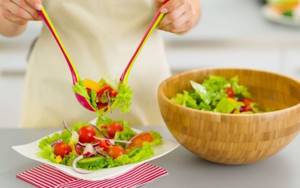
During the period of remission, with the permission of the attending physician, the list of products may be expanded, but the patient must continue to adhere to the basic principles
Broth with added egg
You need to prepare broth from lean meats (veal, beef, poultry). For 1 liter of finished product, 2 eggs are used. They need to be mixed and poured into hot liquid. Serve with homemade white bread croutons.
Meatballs
Chicken or veal must be passed through a meat grinder or chopped in a blender. Place white bread (100 grams) soaked in milk into the minced meat and add an egg. Knead thoroughly and add salt. Make small meatballs and place in boiling water. Once the meatballs float to the surface, cook them for 10 minutes.
Potato and zucchini puree
Boil a small young zucchini and several potatoes in salted water. Grind until puree. Season with a piece of butter.
Omelette with cauliflower
Separate the cauliflower into florets. Boil them. Grease an oven dish with oil and lay out the cabbage “mushrooms”. Add 2 eggs to 150 ml of milk. Beat and pour over cabbage. Steam.
Meat pate
Boil 1 kg of chicken or veal along with 1 carrot. Pass the finished meat through a meat grinder twice. Add a little butter and stir.
Milk noodle soup
Prepare homemade noodles: combine a glass of flour with an egg and 1 tbsp. l. water. Knead and roll out thin pancakes. Let them dry a little. Roll into a roll and cut into strips. Place noodles in boiling water and cook for 10-15 minutes. Bring milk to a boil (3.5 cups). Pour it over the prepared noodles, add salt and sweeten. When serving, place a piece of butter on a plate.
Gastroesophageal reflux disease is a complex disease, effective therapy of which is impossible without diet. As a rule, the patient is forced to adhere to the principles of therapeutic nutrition throughout his life.


